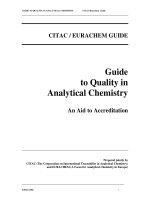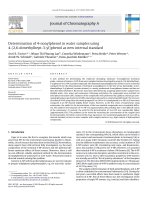Equilibrium in Analytical Chemistry Using Maple
Bạn đang xem bản rút gọn của tài liệu. Xem và tải ngay bản đầy đủ của tài liệu tại đây (12.84 MB, 226 trang )
EquilibriuminAnalyticalChemistry
UsingMaple®
AnemphasisonIonicEquilibrium-PartII
Prof.R.V.Whiteley
Downloadfreebooksat
Prof. R.V. Whiteley, Jr., Paciic University Oregon
Equilibrium in Analytical Chemistry
Using Maple®
An emphasis on Ionic Equilibrium – Part II
2
Download free eBooks at bookboon.com
Equilibrium in Analytical Chemistry Using Maple®
An emphasis on Ionic Equilibrium – Part II
© 2013 Prof. R.V. Whiteley, Jr., Paciic University Oregon & bookboon.com
ISBN 978-87-403-0424-4
3
Download free eBooks at bookboon.com
Equilibrium in Analytical
Chemistry Using Maple®
Contents
Contents
To see Part I download Equilibrium in Analytical Chemistry Using Maple Part I
Preface
Part I
1
he Fundamentals of Chemical Equilibrium
Part I
2
Ionic Strength, Activity Coeicients and an Introduction to Maple
Part I
3
Strong Electrolytes, pH and the Mathematics of Ionic Equilibrium
Part I
4
Weak Acids and Weak Bases
Part I
5
he Salts of Weak Acids and Weak Bases
Part I
6
Bufer Solutions
Part I
7
Acid / Base Titrations and an Introduction to Maple Programming
Part I
www.sylvania.com
We do not reinvent
the wheel we reinvent
light.
Fascinating lighting offers an ininite spectrum of
possibilities: Innovative technologies and new
markets provide both opportunities and challenges.
An environment in which your expertise is in high
demand. Enjoy the supportive working atmosphere
within our global group and beneit from international
career paths. Implement sustainable ideas in close
cooperation with other specialists and contribute to
inluencing our future. Come and join us in reinventing
light every day.
Light is OSRAM
4
Download free eBooks at bookboon.com
Click on the ad to read more
Equilibrium in Analytical
Chemistry Using Maple®
Contents
8
Polyprotic Acids and Bases
7
9
Complexometric Chemical Equilibrium
10
Solubility Equilibrium
110
Appendix I
174
53
Solvent Parameters for Calculations of Aqueous Solutions
Using Extended Debye-Hückel heory
174
Appendix II
175
Constants for Calculating Activity Coeicients
175
Appendix III
177
Autoprotolysis Constants for Water
177
Appendix IV
178
Acid Dissociation Constants for Some Common Weak Acids
178
Appendix V
182
Properties of Some Common Acid / Base Indicators
182
360°
thinking
.
Discover the truth at www.deloitte.ca/careers
5
Download free eBooks at bookboon.com
© Deloitte & Touche LLP and affiliated entities.
Click on the ad to read more









